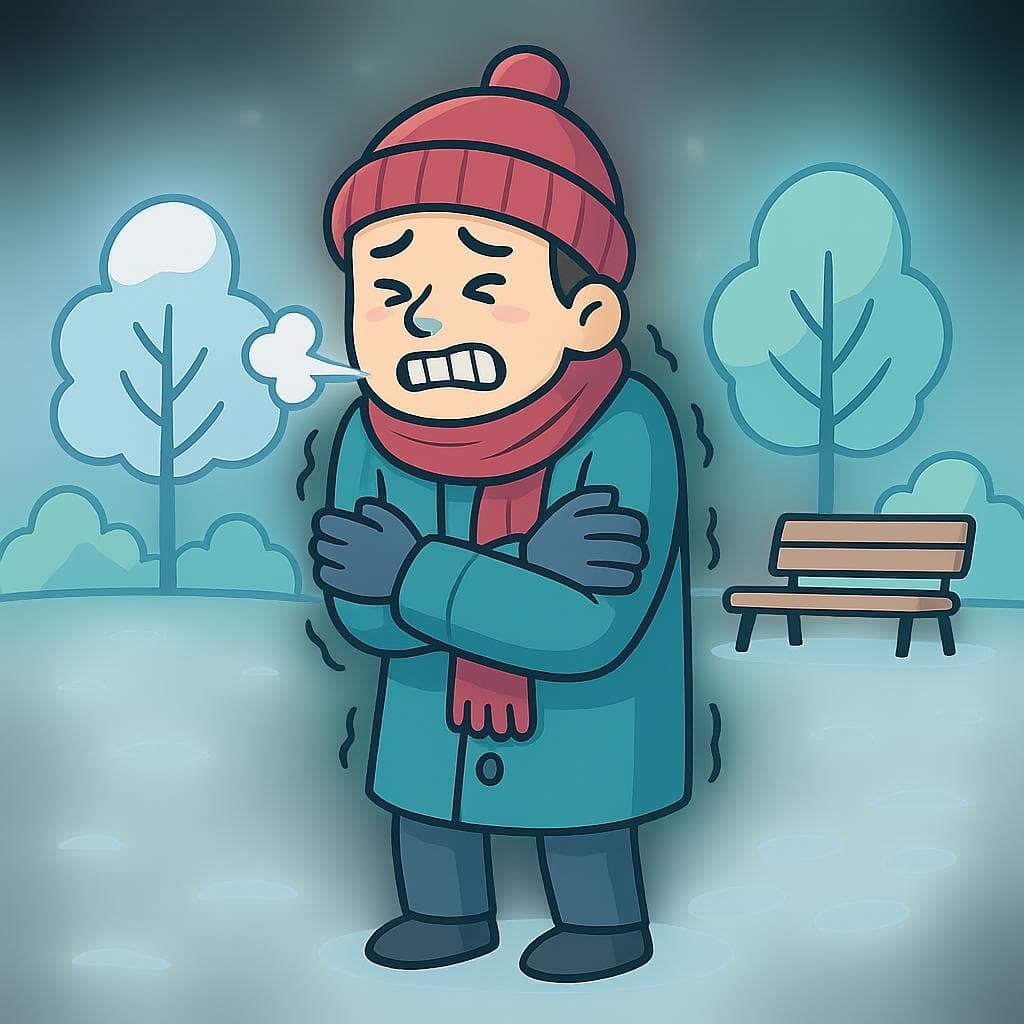I am freezing
in SpanishTengo mucho frío
/TEN-go MOO-cho FREE-oh/
This is the most common and standard way to say you're very cold. Spanish uses the verb 'tener' (to have) for physical sensations like cold, heat, and hunger, which is a key difference from English.

Whether you 'have cold' (tengo frío) or are 'dying of cold' (me muero de frío), Spanish offers many ways to express you're freezing.
💬Other Ways to Say It
Me muero de frío
/meh MWER-oh deh FREE-oh/
A very common and dramatic way to say you're freezing. It literally means "I'm dying of cold," and is a classic hyperbole used for emphasis in casual conversation.
Me estoy congelando
/meh ehs-TOY con-heh-LAHN-doh/
A more literal translation of "I am freezing," using the verb 'congelar' (to freeze). It's very common and adds a touch of drama.
Estoy helado/a
/ehs-TOY eh-LAH-doh / eh-LAH-dah/
This literally means "I am frozen/iced." It uses the verb 'estar' and the adjective must match your gender: 'helado' for a male speaker, 'helada' for a female speaker.
¡Qué frío hace!
/keh FREE-oh AH-seh/
While this talks about the weather ("How cold it is!"), it's used constantly to express that you feel cold. It’s a common way to start a conversation about the temperature.
Hace un frío que pela
/AH-seh oon FREE-oh keh PEH-lah/
A very colloquial and expressive idiom from Spain. It literally means "It's a cold that peels," implying the cold is so sharp it could peel your skin.
Estoy tiritando de frío
/ehs-TOY tee-ree-TAHN-doh deh FREE-oh/
This describes the physical reaction to being cold. 'Tiritar' means to shiver or tremble. It's a very descriptive phrase.
🔑Key Words
Key Words to learn:
📊Quick Comparison
Here’s a quick guide to choosing the best phrase for how cold you are and who you're talking to.
| Phrase | Formality | Best For | Avoid When |
|---|---|---|---|
| Tengo mucho frío | Neutral | Never. It's always appropriate. | |
| Me muero de frío | Informal | Very formal or professional settings where hyperbole might seem out of place. | |
| Me estoy congelando | Informal | A business meeting or formal dinner. | |
| Estoy helado/a | Neutral | It's generally fine, but 'tengo frío' is slightly more common for the general feeling. |
📈Difficulty Level
Most sounds are easy for English speakers. The rolled 'r' in 'frío' might take a little practice but is not a major barrier to being understood.
The concept of using 'tener' (to have) instead of 'ser/estar' (to be) for a feeling is a significant grammatical hurdle and a common source of errors for beginners.
Usage is fairly straightforward, but knowing when to use dramatic, hyperbolic expressions versus the standard phrase adds a layer of cultural fluency.
Key Challenges:
- Breaking the habit of translating 'I am' directly to 'Estoy'
- Remembering to use 'tener' for cold, heat, hunger, and thirst
- Matching the gender for adjectives like 'helado/a'
💡Examples in Action
Cierra la ventana, por favor. ¡Me estoy congelando!
Close the window, please. I'm freezing!
Uf, salí sin chaqueta y ahora me muero de frío.
Ugh, I went out without a jacket and now I'm dying of cold.
No puedo sentir mis dedos. Tengo mucho frío.
I can't feel my fingers. I'm freezing.
Después de nadar en el lago en abril, estaba completamente helada.
After swimming in the lake in April, I was completely frozen.
🌍Cultural Context
Having Cold vs. Being Cold
The biggest mental shift for English speakers is that in Spanish, you 'have' cold ('tener frío'). You don't 'are' cold. Think of cold as a separate thing that you possess temporarily. This applies to other bodily sensations too, like hunger ('tengo hambre'), thirst ('tengo sed'), and heat ('tengo calor').
The Art of Exaggeration
Spanish speakers often use hyperbole in everyday conversation to be more expressive. Phrases like 'Me muero de frío' (I'm dying of cold) are extremely common and not taken literally. Embracing these dramatic phrases will make your Spanish sound much more natural and fluent in casual settings.
Weather as a Social Glue
Just like in English, commenting on the weather is a universal icebreaker. Saying '¡Qué frío hace!' to a shopkeeper or someone at a bus stop is a perfectly normal and friendly way to start a brief conversation. It's a low-stakes way to connect with people.
❌ Common Pitfalls
Using 'Estar' or 'Ser' Instead of 'Tener'
Mistake: "A learner says: "Estoy frío.""
Correction: The correct way is: "Tengo frío."
Forgetting Gender Agreement
Mistake: "A female speaker says: "Estoy helado.""
Correction: She should say: "Estoy helada."
Confusing 'Hace Frío' and 'Tengo Frío'
Mistake: "A learner says: "Yo hago frío.""
Correction: To describe your feeling: "Tengo frío." To describe the weather: "Hace frío."
💡Pro Tips
When in Doubt, 'Tengo Frío'
If you're ever unsure which phrase to use, 'Tengo frío' is your safest bet. It's 100% correct, universally understood, and appropriate in any situation, formal or informal. To add emphasis, just say 'Tengo mucho frío'.
Level Up with Dramatic Flair
To sound more like a native speaker in casual contexts, start using the more expressive variations. Try 'Me muero de frío' or 'Me estoy congelando' with friends. They'll appreciate your expressive use of the language.
Listen for the Context
Pay attention to how people around you talk about the cold. Do they comment on the weather ('Hace frío')? Or do they describe their personal feeling ('Tengo frío')? Noticing this will help you respond more naturally in conversations.
🗺️Regional Variations
Spain
Spain is famous for its colorful and sometimes crude idioms. Phrases like 'hace un frío que pela' are very common in casual speech and will make you sound very authentic. The 'distinción' pronunciation of 'c' and 'z' is also a key feature.
Mexico
Mexicans often add the augmentative suffix '-azo' to nouns to mean 'very big' or 'intense'. 'Friazo' is a very common, informal way to say it's intensely cold. It's casual and very natural-sounding.
Argentina
Argentinian Spanish, particularly from the Rioplatense region, is known for being direct and using vocabulary that might be considered vulgar in other countries. 'Me cago de frío' is extremely common and not as offensive as its literal translation suggests in casual contexts.
💬What Comes Next?
You say, 'Tengo mucho frío.'
¿Quieres mi chaqueta/abrigo?
Do you want my jacket/coat?
Sí, gracias, qué amable.
Yes, thank you, how kind.
You exclaim, '¡Qué frío hace!'
Sí, terrible. No me esperaba este tiempo.
Yes, it's terrible. I wasn't expecting this weather.
Yo tampoco. ¡Necesito un café caliente ahora mismo!
Me neither. I need a hot coffee right now!
You shiver and say, 'Me estoy congelando.'
Ponte al lado de la calefacción.
Go stand next to the heater.
Buena idea, gracias.
Good idea, thanks.
🧠Memory Tricks
This little story connects the English words 'go' and 'tent' to the sound of 'Tengo'. It helps you remember to use the verb 'tener' (to have) for the feeling of being cold.
🔄How It Differs from English
The fundamental difference is linguistic and conceptual. English treats cold as a state of being ('I *am* cold'), using the verb 'to be'. Spanish treats cold as a noun, a sensation that you possess ('I *have* cold'). This 'tener' vs. 'to be' distinction for feelings and sensations is one of the most important structural differences to master when learning Spanish.
False Friends & Common Confusions:
Why it's different: A direct translation to 'Estoy frío' is incorrect for describing the feeling of being cold. 'Estoy frío' describes your personality (cold, distant) or your physical body temperature to the touch (like a medical situation).
Use instead: Use 'Tengo frío' to express the feeling of being cold. Use 'Soy una persona fría' to say 'I am a cold person' (personality).
🎯Your Learning Path
➡️ Learn Next:
How to say 'I am hot'
It uses the same 'tener' structure ('Tengo calor') and is the direct opposite, helping you solidify the grammar concept.
How to talk about the weather
This expands on 'Hace frío' and teaches you how to discuss rain, sun, and wind, which are essential small talk topics.
How to say 'I'm hungry' and 'I'm thirsty'
These phrases ('Tengo hambre' and 'Tengo sed') reinforce the critical use of 'tener' for bodily sensations.
How to say 'Can you close the window?'
This is a natural follow-up to saying you're cold and helps you learn how to make polite requests.
✏️Test Your Knowledge
💡 Quick Quiz: I am freezing
Question 1 of 3
You step outside into a blizzard. What's the most common and dramatic way to tell your friend how you feel?
Frequently Asked Questions
Why can't I say 'Estoy frío' like in English?
Because in Spanish, feelings like cold, hunger, and thirst are treated as things you 'have' (tener), not states you 'are' (estar). Saying 'Estoy frío' changes the meaning to describe your personality as 'cold' or your body as literally cold to the touch, which can sound strange or even alarming.
What's the difference between 'Tengo frío' and 'Hace frío'?
'Tengo frío' is personal; it describes how *you* feel. 'Hace frío' is impersonal; it describes the weather outside. You can say 'Hace frío, por eso tengo frío' ('It's cold out, that's why I'm cold').
Is 'Me muero de frío' too dramatic to say?
Not at all in casual situations! It's a very common exaggeration that Spanish speakers use all the time. While it sounds extreme in English, it's a normal, everyday expression of feeling very cold among friends and family.
Do I always have to say 'helado' or 'helada' to match my gender?
Yes, when you use it as an adjective with the verb 'estar' (e.g., 'Estoy helada'), it must match your gender. However, the main phrase 'Tengo frío' doesn't change for gender because 'frío' is used as a noun in that case.
How can I emphasize that I'm REALLY freezing?
You have many options! You can add 'mucho' to the standard phrase: 'Tengo mucho frío.' Or, for more impact, use the dramatic expressions: 'Me estoy congelando' (I'm freezing) or 'Me muero de frío' (I'm dying of cold).
Are phrases like 'Hace un frío que pela' used everywhere?
No, that specific one is very characteristic of Spain. While many expressions are universal, some idiomatic ways of talking about the weather are regional. It's always great to learn the local flavor of the country you're in!
📚Continue Learning Spanish Phrases
Explore More Phrases in These Categories
Find similar phrases to expand your Spanish vocabulary:
Want to Learn More Spanish Phrases?
Browse our complete collection of Spanish phrases organized by situation, from basic greetings to advanced conversations. Perfect for travelers, students, and anyone learning Spanish.
View All Spanish Phrases →




